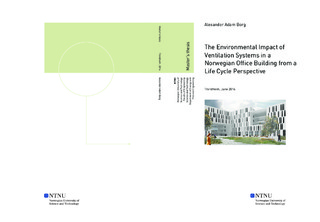| dc.description.abstract | The main topic of this thesis has been a study of the environmental impacts of the ventilation system in Abels Hus, an office building in Trondheim, from a life cycle perspective. The objective of the study has been to develop a methodology for easier Life Cycle Assessment (LCA) of buildings based on Building Information Models (BIM) and the scope has been a cradle-to-grave analysis.
The background for the study is the increased complexity of technical installations in buildings leading to a need for reassessment of the share of impacts that belong to embodied emissions, while also taking into consideration more impact categories than just climate change. Additionally, the conventional LCA methodology does not sufficiently reflect the time-dependent impact of greenhouse gases when considering systems with such a long lifetime as a building. Thus, a dynamic methodology is applied to better encompass the long lifetime of buildings.
A literature study on Life Cycle Assessments of buildings revealed that the use phase constitutes the majority of impacts throughout the buildings lifetime. To explore these findings a BIM model has been used to find inventory data on a ventilation system.
A supplied dataset, combined with environmental product declarations and component data sheets was used to create the inventory for the embodied impacts in the building components, and energy simulations gave the energy use throughout the use phase of the building. To model impacts to climate change for construction and demolition services, input output analysis was applied with the use of modified input-output tables for construction.
Scenario analyses were performed through variations in the electricity supply mix. Four supply mixes were analysed: The Norwegian Mix, Nordic, EU very optimistic, and EU realistic-optimistic. Recycled content of the steel in the ventilation system was also varied. Uncertainties of the embodied impacts were assessed through Monte Carlo simulation.
The results show that energy use constitutes the majority of the impacts for most impact categories, but embodied impacts have a larger share of emissions than previously shown in literature, although total impacts coincide with literature data. The dynamic LCA gives a 33\% lower result in climate change impacts than the conventional LCA, and it better shows when in the life cycle the impacts occur, while also keeping consistent with the given time horizon. The ventilation impacts from energy consumptions in the use phase constitute 22\%-33\% of total emissions from energy consumption.
Policy makers should consider a reduction in embodied impacts of ventilation systems, through increased recycled content of materials, and alternative ventilation methods like hybrid natural ventilation. Without a standardization of BIM models, LCA through BIM is very time consuming, but with the recent developments in BIM standards, these could prove a viable tool for environmental assessments in the early design stages. | |

